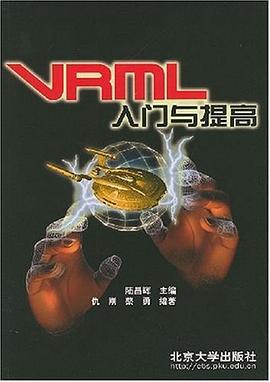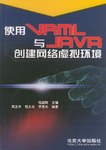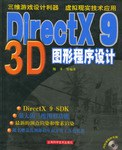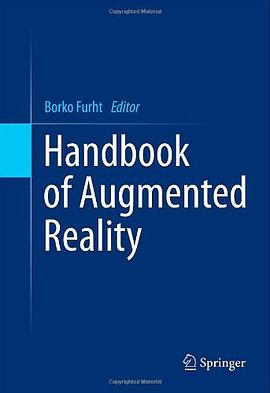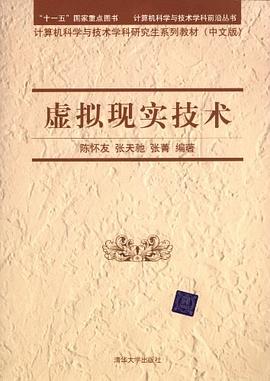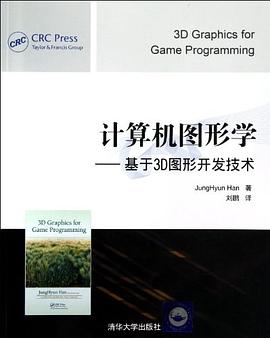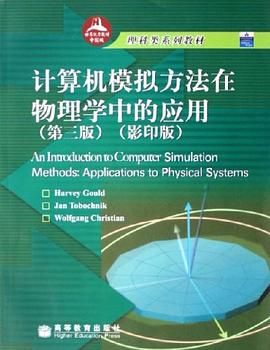

具體描述
主頁:http://sip.clarku.edu/
本書是在美國大學使用很廣泛的一本經典的,講解如何使用計算機進行物理學數字模擬的教材,該書為剛剛齣版的第三版。該書不是簡單的物理學研究中的數學方法的介紹,而更注重在使用計算機模擬物理學問題中幫助學生更深刻的理解物理學,幫助學生在學習中瞭解和掌握使用計算機做物理學研究的一些基本手段,並學會如何根據具體的物理問題選擇相應的研究方法。此外,還通過對具體的例子的講解也為學習物理學的學生介紹瞭物理學廣闊的應用天地。 本書可作為高等學校物理類專業或其它理工類專業計算物理課程的教材或參考書,對於相關學科的研究人員也是一本有用的參考書。
著者簡介
圖書目錄
~~~ Introduction
1.1 Importance of Computers in Physics
1.2 The Importance of Computer Simulation
1.3 Programming Languages
1.4 Object-Oriented Techniques
1.5 How to Use this Book
Appendix 1A: Laboratory Reports
2 ~~ Tools for Doing Simulations
2. l Introduction
2.2 Simulating Free Fall
2.3 Getting Started with Object-Oriented Programming
2.4 Inheritance
2.5 The Open Source Physics Library
2.6 Animation and Simulation
2.7 Model-View-Controller
Appendix 2A: Complex Numbers
3 ~~ Simulating Particle Motion
3.1 Modified Euler Algorithms
3.2 Interfaces
. 3.3 Drawing
3.4 Specifying the State of a System Using Arrays
3.5 The ODE Interface
3.6 The ODESolver Interface
3.7 Effects of Drag Resistance
3.8 Two-Dimensional Trajectories
3.9 Decay Processes
*3.10 Visualizing Three-Dimensional Motion
3.11 Levels of Simulation
Appendix 3A: Numerical Integration of Newton's Equation of Motion
4 ~~ Oscillatory Systems
4.1 Simple Harmonic Motion
4.2 The Motion of a Pendulum
4.3 Damped Harmonic Oscillator
4.4 Response to External Forces
4.5 Electrical Circuit Oscillations
4.6 Accuracy and Stability
4.7 Projects
5 ~~ Few-Body Problems: The Motion of the Planets
5. l Planetary Motion
5.2 The Equations of Motion
5.3 Circular and Elliptical Orbits
5.4 Astronomical Units
5.5 Log-Log and Semilog Plots
5.6 Simulation of the Orbit
5.7 Impulsive Forces
5.8 Velocity Space
5.9 AMini-Solar System
5.10 Two-Body Scattering
5.11 Three-Body Problems
5.12 Projects
6 ~~ The Chaotic Motion of Dynamical Systems
6.1 Introduction
6.2 ASimple One-Dimensional Map
6.3 Period Doubling
6.4 Universal Properties and Self-Similarity
6.5 Measuring Chaos
*6.6 Controlling Chaos
6.7 Higher-Dimensional Models
6.8 Forced Damped Pendulum
*6.9 Hamiltonian Chaos
6.10 Perspective
6.11 Projects
Appendix 6A: Stability of the Fixed Points of the Logistic Map
Appendix 6B: Finding the Roots of a Function
7 ~~ Random Processes
7.1 Order to Disorder
7.2 Random Walks
7.3 Modified Random Walks
7.4 The Poisson Distribution and Nuclear Decay
7.5 Problems in Probability
7.6 Method of Least Squares
7.7 Applications to Polymers
7.8 Diffusion-Controlled Chemical Reactions
7.9 Random Number Sequences
7.10 Variational Methods
7.11 Projects
Appendix 7A: Random Walks and the Diffusion Equation
8 ~~ The Dynamics of Many-Particle Systems
8.1 Introduction
8.2 The Interrnolecular Potential
8.3 Units
8.4 The Numerical Algorithm
8.5 Periodic Boundary Conditions
8.6 A Molecular Dynamics Program
8.7 Thermodynamic Quantities
8.8 Radial Distribution Function
8.9 Hard Disks
8.10 Dynamical Properties
8.11 Extensions
8.12 Projects
Appendix 8A: Reading and Saving Configurations
9 ~~ Normal Modes and Waves
9.1 Coupled Oscillators and Normal Modes
9.2 Numerical Solutions
9.3 Fourier Series
9.4 Two-Dimensional Fourier Series
9.5 Fourier Integrals
9.6 Power Spectrum
9.7 Wave Motion
9.8 Interference
9.9 Fraunhofer Diffraction
9.10 Fresnel Diffraction
Appendix 9A: Complex Fourier Series
Appendix 9B: Fast Fourier Transform
Appendix 9C: Plotting Scalar Fields
10 ~~ Electrodynamics
10.1 Static Charges
10.2 Electric Fields
10.3 Electric Field Lines
10.4 Electric Potential
10.5 Numerical Solutions of Boundary Value Problems
10.6 Random Walk Solution of Laplace's Equation
"10.7 Fields Due to Moving Charges
"10.8 Maxwell's Equations
10.9 Projects 407
Appendix 10A: Plotting Vector Fields
11 ~~ Numerical and Monte Carlo Methods
11.1 Numerical Integration Methods in One Dimension
11.2 Simple Monte Carlo Evaluation of Integrals
11.3 Multidimensional Integrals
11.4 Monte Carlo Error Analysis
11.5 Nonuniform Probability Distributions
11.6 Importance Sampling
11.7 Metropolis Algorithm
* 11.8 Neutron Transport
Appendix 11A: Error Estimates for Numerical Integration
Appendix 11B: The Standard Deviation of the Mean
Appendix 11C: The Acceptance-Rejection Method
Appendix llD: Polynomials and Interpolation
12 ~~ Percolation
12.1 Introduction
12.2 The Percolation Threshold
12.3 Finding Clusters
12.4 Critical Exponents and Finite Size Scaling
12.5 The Renormalization Group
12.6 Projects
13 ~~ Fractals and Kinetic Growth Models
13.1 The Fractal Dimension
13.2 Regular Fractals
13.3 Kinetic Growth Processes
13.4 Fractals and Chaos
13.5 Many Dimensions
13.6 Projects
14 ~~ Complex Systems
14.1 Cellular Automata
14.2 Self-Organized Critical Phenomena
14.3 The Hopfield Model and Neural Networks
14.4 Growing Networks
14.5 Genetic Algorithms
14.6 Lattice Gas Models of Fluid Flow
14.7 Overview and Projects
15 ~~ Monte Carlo Simulations of Thermal Systems
15.1 Introduction
15.2 The Microcanonical Ensemble
15.3 The Demon Algorithm
15.4 The Demon as a Thermometer
15.5 The Ising Model
15.6 The Metropolis Algorithm
15.7 Simulation of the Ising Model
15.8 The Ising Phase Transition
15.9 Other Applications of the Ising Model
15.10 Simulation of Classical Fluids
15.11 Optimized Monte Carlo Data Analysis
* 15.12 Other Ensembles
15.13 More Applications
15.14 Projects
Appendix 15A: Relation of the Mean Demon Energy to the Temperature
Appendix 15B: Fluctuations in the Canonical Ensemble
Appendix 15C: Exact Enumeration of the 2 x 2 Ising Model
16 ~~ Quantum Systems
16.1 Introduction
16.2 Review of Quantum Theory
16.3 Bound State Solutions
16.4 Time Development of Eigenstate Superpositions
16.5 The Time-Dependent Schrrdinger Equation
16.6 Fourier Transformations and Momentum Space
16.7 Variational Methods
16.8 Random Walk Solutions of the Schrrdinger Equation
16.9 Diffusion Quantum Monte Carlo
16.10 Path Integral Quantum Monte Carlo
16.11 Projects
Appendix 16A: Visualizing Complex Functions
17 ~~ Visualization and Rigid Body Dynamics
17.1 Two-Dimensional Transformations
17.2 Three-Dimensional Transformations
17.3 The Three-Dimensional Open Source Physics Library
17.4 Dynamics of a Rigid Body
17.5 Quaternion Arithmetic
17.6 Quaternion Equations of Motion
17.7 Rigid Body Model
17.8 Motion of a Spinning Top
17.9 Projects
Appendix 17A: Matrix Transformations
Appendix 17B: Conversions
18 ~~ Seeing in Special and General Relativity
t8.1 Special Relativity
18.2 General Relativity
18.3 Dynamics in Polar Coordinates
18.4 Black Holes and Schwarzschild Coordinates
18.5 Particle and Light Trajectories
18.6 Seeing
18.7 General Relativistic Dynamics
* 18.8 The Kerr Metric
18.9 Projects
19 ~~ Epilogue: The Unity of Physics
19.1 The Unity of Physics
19.2 Spiral Galaxies
19.3 Numbers, Pretty Pictures, and Insight
19.4 Constrained Dynamics
19.5 What are Computers Doing to Physics?
Index~
· · · · · · (收起)
1.1 Importance of Computers in Physics
1.2 The Importance of Computer Simulation
1.3 Programming Languages
1.4 Object-Oriented Techniques
1.5 How to Use this Book
Appendix 1A: Laboratory Reports
2 ~~ Tools for Doing Simulations
2. l Introduction
2.2 Simulating Free Fall
2.3 Getting Started with Object-Oriented Programming
2.4 Inheritance
2.5 The Open Source Physics Library
2.6 Animation and Simulation
2.7 Model-View-Controller
Appendix 2A: Complex Numbers
3 ~~ Simulating Particle Motion
3.1 Modified Euler Algorithms
3.2 Interfaces
. 3.3 Drawing
3.4 Specifying the State of a System Using Arrays
3.5 The ODE Interface
3.6 The ODESolver Interface
3.7 Effects of Drag Resistance
3.8 Two-Dimensional Trajectories
3.9 Decay Processes
*3.10 Visualizing Three-Dimensional Motion
3.11 Levels of Simulation
Appendix 3A: Numerical Integration of Newton's Equation of Motion
4 ~~ Oscillatory Systems
4.1 Simple Harmonic Motion
4.2 The Motion of a Pendulum
4.3 Damped Harmonic Oscillator
4.4 Response to External Forces
4.5 Electrical Circuit Oscillations
4.6 Accuracy and Stability
4.7 Projects
5 ~~ Few-Body Problems: The Motion of the Planets
5. l Planetary Motion
5.2 The Equations of Motion
5.3 Circular and Elliptical Orbits
5.4 Astronomical Units
5.5 Log-Log and Semilog Plots
5.6 Simulation of the Orbit
5.7 Impulsive Forces
5.8 Velocity Space
5.9 AMini-Solar System
5.10 Two-Body Scattering
5.11 Three-Body Problems
5.12 Projects
6 ~~ The Chaotic Motion of Dynamical Systems
6.1 Introduction
6.2 ASimple One-Dimensional Map
6.3 Period Doubling
6.4 Universal Properties and Self-Similarity
6.5 Measuring Chaos
*6.6 Controlling Chaos
6.7 Higher-Dimensional Models
6.8 Forced Damped Pendulum
*6.9 Hamiltonian Chaos
6.10 Perspective
6.11 Projects
Appendix 6A: Stability of the Fixed Points of the Logistic Map
Appendix 6B: Finding the Roots of a Function
7 ~~ Random Processes
7.1 Order to Disorder
7.2 Random Walks
7.3 Modified Random Walks
7.4 The Poisson Distribution and Nuclear Decay
7.5 Problems in Probability
7.6 Method of Least Squares
7.7 Applications to Polymers
7.8 Diffusion-Controlled Chemical Reactions
7.9 Random Number Sequences
7.10 Variational Methods
7.11 Projects
Appendix 7A: Random Walks and the Diffusion Equation
8 ~~ The Dynamics of Many-Particle Systems
8.1 Introduction
8.2 The Interrnolecular Potential
8.3 Units
8.4 The Numerical Algorithm
8.5 Periodic Boundary Conditions
8.6 A Molecular Dynamics Program
8.7 Thermodynamic Quantities
8.8 Radial Distribution Function
8.9 Hard Disks
8.10 Dynamical Properties
8.11 Extensions
8.12 Projects
Appendix 8A: Reading and Saving Configurations
9 ~~ Normal Modes and Waves
9.1 Coupled Oscillators and Normal Modes
9.2 Numerical Solutions
9.3 Fourier Series
9.4 Two-Dimensional Fourier Series
9.5 Fourier Integrals
9.6 Power Spectrum
9.7 Wave Motion
9.8 Interference
9.9 Fraunhofer Diffraction
9.10 Fresnel Diffraction
Appendix 9A: Complex Fourier Series
Appendix 9B: Fast Fourier Transform
Appendix 9C: Plotting Scalar Fields
10 ~~ Electrodynamics
10.1 Static Charges
10.2 Electric Fields
10.3 Electric Field Lines
10.4 Electric Potential
10.5 Numerical Solutions of Boundary Value Problems
10.6 Random Walk Solution of Laplace's Equation
"10.7 Fields Due to Moving Charges
"10.8 Maxwell's Equations
10.9 Projects 407
Appendix 10A: Plotting Vector Fields
11 ~~ Numerical and Monte Carlo Methods
11.1 Numerical Integration Methods in One Dimension
11.2 Simple Monte Carlo Evaluation of Integrals
11.3 Multidimensional Integrals
11.4 Monte Carlo Error Analysis
11.5 Nonuniform Probability Distributions
11.6 Importance Sampling
11.7 Metropolis Algorithm
* 11.8 Neutron Transport
Appendix 11A: Error Estimates for Numerical Integration
Appendix 11B: The Standard Deviation of the Mean
Appendix 11C: The Acceptance-Rejection Method
Appendix llD: Polynomials and Interpolation
12 ~~ Percolation
12.1 Introduction
12.2 The Percolation Threshold
12.3 Finding Clusters
12.4 Critical Exponents and Finite Size Scaling
12.5 The Renormalization Group
12.6 Projects
13 ~~ Fractals and Kinetic Growth Models
13.1 The Fractal Dimension
13.2 Regular Fractals
13.3 Kinetic Growth Processes
13.4 Fractals and Chaos
13.5 Many Dimensions
13.6 Projects
14 ~~ Complex Systems
14.1 Cellular Automata
14.2 Self-Organized Critical Phenomena
14.3 The Hopfield Model and Neural Networks
14.4 Growing Networks
14.5 Genetic Algorithms
14.6 Lattice Gas Models of Fluid Flow
14.7 Overview and Projects
15 ~~ Monte Carlo Simulations of Thermal Systems
15.1 Introduction
15.2 The Microcanonical Ensemble
15.3 The Demon Algorithm
15.4 The Demon as a Thermometer
15.5 The Ising Model
15.6 The Metropolis Algorithm
15.7 Simulation of the Ising Model
15.8 The Ising Phase Transition
15.9 Other Applications of the Ising Model
15.10 Simulation of Classical Fluids
15.11 Optimized Monte Carlo Data Analysis
* 15.12 Other Ensembles
15.13 More Applications
15.14 Projects
Appendix 15A: Relation of the Mean Demon Energy to the Temperature
Appendix 15B: Fluctuations in the Canonical Ensemble
Appendix 15C: Exact Enumeration of the 2 x 2 Ising Model
16 ~~ Quantum Systems
16.1 Introduction
16.2 Review of Quantum Theory
16.3 Bound State Solutions
16.4 Time Development of Eigenstate Superpositions
16.5 The Time-Dependent Schrrdinger Equation
16.6 Fourier Transformations and Momentum Space
16.7 Variational Methods
16.8 Random Walk Solutions of the Schrrdinger Equation
16.9 Diffusion Quantum Monte Carlo
16.10 Path Integral Quantum Monte Carlo
16.11 Projects
Appendix 16A: Visualizing Complex Functions
17 ~~ Visualization and Rigid Body Dynamics
17.1 Two-Dimensional Transformations
17.2 Three-Dimensional Transformations
17.3 The Three-Dimensional Open Source Physics Library
17.4 Dynamics of a Rigid Body
17.5 Quaternion Arithmetic
17.6 Quaternion Equations of Motion
17.7 Rigid Body Model
17.8 Motion of a Spinning Top
17.9 Projects
Appendix 17A: Matrix Transformations
Appendix 17B: Conversions
18 ~~ Seeing in Special and General Relativity
t8.1 Special Relativity
18.2 General Relativity
18.3 Dynamics in Polar Coordinates
18.4 Black Holes and Schwarzschild Coordinates
18.5 Particle and Light Trajectories
18.6 Seeing
18.7 General Relativistic Dynamics
* 18.8 The Kerr Metric
18.9 Projects
19 ~~ Epilogue: The Unity of Physics
19.1 The Unity of Physics
19.2 Spiral Galaxies
19.3 Numbers, Pretty Pictures, and Insight
19.4 Constrained Dynamics
19.5 What are Computers Doing to Physics?
Index~
· · · · · · (收起)
讀後感
評分
評分
評分
評分
評分
用戶評價
评分
评分
评分
评分
评分
相關圖書
本站所有內容均為互聯網搜索引擎提供的公開搜索信息,本站不存儲任何數據與內容,任何內容與數據均與本站無關,如有需要請聯繫相關搜索引擎包括但不限於百度,google,bing,sogou 等
© 2025 book.quotespace.org All Rights Reserved. 小美書屋 版权所有




